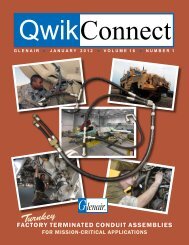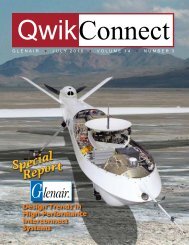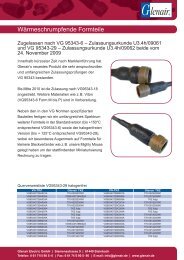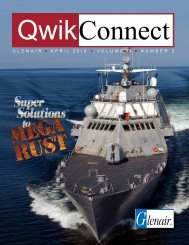RoHS - Glenair UK Ltd
RoHS - Glenair UK Ltd
RoHS - Glenair UK Ltd
You also want an ePaper? Increase the reach of your titles
YUMPU automatically turns print PDFs into web optimized ePapers that Google loves.
On the Hunt for a Cadmium Replacement<br />
Cadmium, a chemical element with the<br />
symbol Cd and atomic number 48,<br />
is a silver-white metal with a melting<br />
temperature of 321°C. When heated above this<br />
temperature, for example in an accidental fire,<br />
cadmium oxide fumes may be emitted. These<br />
fumes are considered to be dangerous to the<br />
environment and human health; which is why<br />
<strong>Glenair</strong> component parts plated with cadmium<br />
are specifically rated to<br />
only 175°C.<br />
While cadmium<br />
oxide exposure risks<br />
in humans are still<br />
relatively unknown,<br />
it has nevertheless<br />
become a goal<br />
of many industries<br />
to proactively eliminate<br />
cadmium from manufactured<br />
products and systems. This<br />
movement is a significant<br />
challenge in our industry, particularly since<br />
military specifications still require the<br />
use of cadmium. In fact, military parts<br />
are currently exempt from cadmium<br />
and other substance reduction<br />
initiatives.<br />
Because of its desirable<br />
functional qualities, electroplated<br />
cadmium has long been applied<br />
to components on commercial and<br />
military land, sea and air systems as<br />
well as NASA space systems. Cadmium<br />
provides up to 1,000 hours of sacrificial<br />
corrosion protection and excellent lubricity and<br />
resistance to galling for threaded applications.<br />
While the reduction and eventual elimination<br />
of cadmium from military systems is a laudable<br />
goal, replacement materials must deliver the<br />
same levels of performance.<br />
2<br />
QwikConnect<br />
The Department of Defense and the<br />
National Aeronautics and Space Administration<br />
(NASA) recently formed the Joint Cadmium<br />
Alternatives Team (JCAT) to identify and validate<br />
alternatives to cadmium for DoD systems and<br />
NASA applications. Working with a variety of<br />
DoD organizations and OEMs, JCAT defined the<br />
functional properties of electroplated cadmium,<br />
the substrates and components to which it is<br />
currently applied, and the desired properties for<br />
potential alternative/replacement materials.<br />
Along with these military and space<br />
pollution prevention initiatives, a number of<br />
governmental controls have emerged<br />
recently. In the United States, the<br />
EPA and several states have<br />
issued regulations restricting the<br />
use of certain heavy metals. The<br />
European Union introduced the<br />
sweeping Restrictions of Hazardous<br />
Substances (<strong>RoHS</strong>) directive. China<br />
has established its own version of<br />
<strong>RoHS</strong>.<br />
The Joint Strike Fighter<br />
(JSF) program is the first<br />
major program to fall<br />
subject to JCAT’s efforts<br />
and is planned to be<br />
cadmium free. Additionally,<br />
JSF program managers<br />
intend to eliminate the use of<br />
hexavalent chromium, another<br />
useful but reportedly toxic<br />
substance integral to a number<br />
of finish treatment options. On the<br />
commercial front, the Boeing 787 “Dreamliner,”<br />
we are told, will be fabricated exclusively from<br />
cad-free materials.<br />
So the hunt for a cadmium replacement is<br />
on, and in this issue of QwikConnect we’ll bring<br />
you up to speed on all the latest developments.<br />
QwikConnect n January 2009











